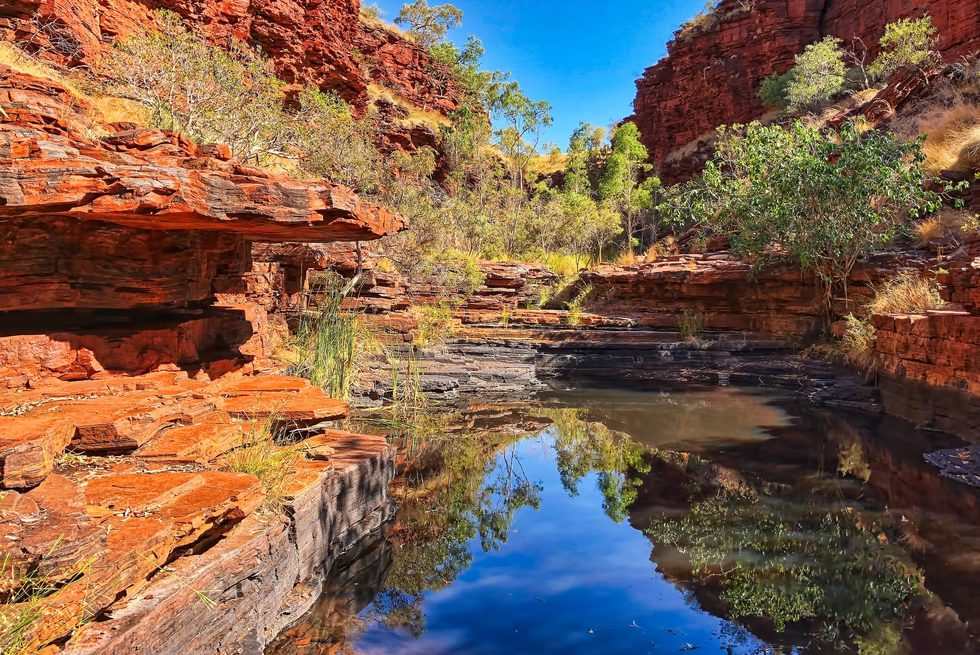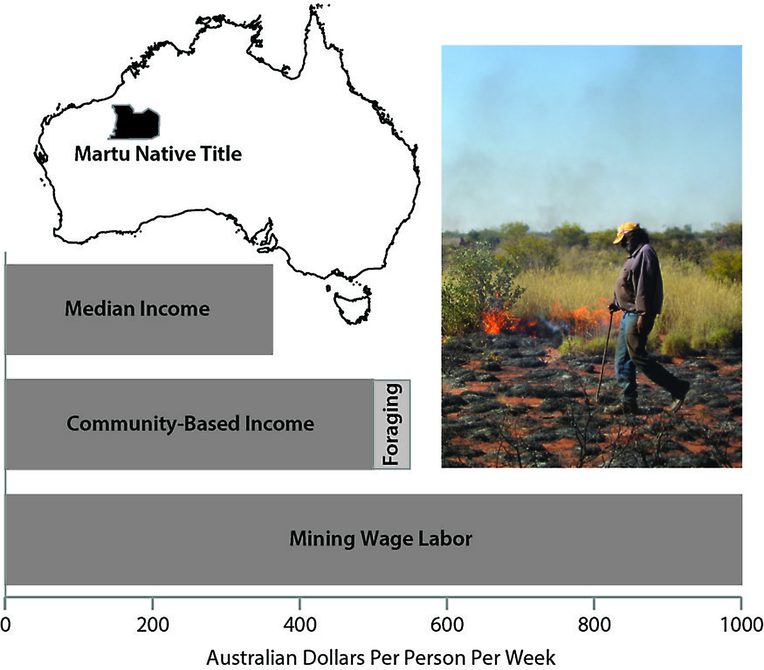Why Not Work for the Mine? Costs and Benefits of Extractive Economies in Remote Aboriginal Australia
From the Series: The Pilbara Crisis: Resource Frontiers in Western Australia
From the Series: The Pilbara Crisis: Resource Frontiers in Western Australia

Western Australia comprises two resource frontiers. Both share a foundation in resource extraction, but while one is driven by global demand, the other is structured by the dynamics of local indigenous economies. This “other” frontier is often referred to as the customary sector of contemporary Aboriginal Australia, which interacts with state and market contexts to form a hybrid economy (Altman 2001). To the confusion of outsiders who do not fully appreciate the complexities of navigating these three sectors, individuals often avoid lucrative market opportunities such as working for local mining operations and instead allocate time to the most traditional activity in the customary economic sector: hunting and gathering. In an attempt to explain this lack of engagement with the global resource frontier, we approach these dynamics with a simple question: why not work for the mine? Drawing on fieldwork with the Martu, an Aboriginal population who have native title over vast estates from the Pilbara to the Percival Lakes and from the Kimberley to Lake Disappointment, we illustrate how engaging in market-oriented activities results in significant costs not apparent in simple economic calculations.
At some basic level, an individual’s choice of work is contingent on the benefits the individual receives from his or her labor. Martu workers in the remote community of Parnngurr can earn approximately A$500 per week (Codding, Bird, and Bird 2015; Codding et al., forthcoming), significantly more than the national median of A$362 per week for an Aboriginal or Torres Strait Islander person over the age of fifteen (Australian Bureau of Statistics 2012). This income derives from a number of sources, including community development projects, the Martu Ranger work program, and producing paintings for sale through the Martumili Artists Cooperative. In addition to these work opportunities, people also supplement their income by foraging for wild resources, the most customary activity of the hybrid economy.
The average adult in Parnngurr community forages 23 of every 100 days and many forage every other day (Bliege Bird et al., forthcoming). On a typical foraging bout, an individual can gain between 2,500 and 3,500 kilocalories for about two and a half hours of work (Codding, Bird, and Bird 2015; Codding et al., forthcoming). Converting these calories to dollars through the equivalent price of food from the community store shows that the average person could add roughly A$45 or A$60 per week to their cash income by foraging three or four days a week,— a roughly 10 percent increase in weekly salary. Importantly, this conversion likely underestimates the dietary importance of foraging, which contributes between 20 and 50 percent of total calories consumed per capita in the community (Bliege Bird et al., forthcoming).
However, if Martu values were defined in simple economic terms, an individual would be better off if he or she left the community for training and work in one of the local mines. Mines in and around Martu country include BHP Billiton’s massive iron ore operation in Newman, Newcrest Mining’s Telfer gold mine, and Cameco Mining’s uranium facility at Kintyre. Working for one of these mines, an individual could increase his or her weekly income to around A$1000 per week. However, this income comes at a significant opportunity cost.

If the Martu gave up customary components of their economic lives, they would also give up as much as half of their calorie intake from fresh, healthy bush foods. Coupled with decreased time out on Country, this would also diminish individual wellness: recent studies have shown that “caring for country”—activities that involve time on the land—produce significant health benefits (Burgess et al. 2009). Perhaps more importantly, in full engagement with the mining economy, an individual gives up extensive family and ritual obligations, severing ties to the land and people that are central to the identity and personhood of many Martu (Bird 2009). In place of family, such a person would have to negotiate interactions with non-Aboriginal coworkers who are, at best, insensitive to their backgrounds and, at worst, may be outright hostile. Non-Aboriginal supervisors often misunderstand the demands on Aboriginal workers as a result of obligations to family, to the land, and to their ancestors. Neglecting these obligations is no small thing. Doing so essentially means that Martu have to give up who they are.
Moreover, giving up being Martu has consequences far beyond the individual and his or her identity. Maintaining a customary component of Martu economies feeds back to provide important benefits to the public at large (Moritz, Ens, and Altman 2015). In order to hunt, Martu burn their country in a way that increases biodiversity (Bliege Bird et al. 2008), buffers the region from the effects of climate-driven wildfires (Bliege Bird et al. 2012), and maintains habitat for endemic fauna (Codding et al. 2014). Such ecosystem services save the public far more than the government currently invests in remote Aboriginal communities (Bliege Bird et al., forthcoming; Codding, Bird, and Bird 2015).
Taken together, the Martu have plenty of reasons not to work for the mine, and other Australians have plenty of reasons to support Martu decisions to engage in traditional economic pursuits on the “other” resource frontier. However, this support is not typically forthcoming. The Western Australian government prioritizes the globally driven resource frontier at the cost of the locally driven traditional economy, which threatens to have dire consequences (Langton 2012). Beyond questions of preserving cultural heritage, the issue of whether the “other” resource frontier is recognized will partially determine the future sovereignty of the original Australians and the future of Western Australia’s economic and ecological landscape.
Altman, Jon C. 2001. “Sustainable Development Options on Aboriginal Land: The Hybrid Economy in the Twenty-First Century.” Discussion Paper, no. 226. Canberra: Centre for Aboriginal Economic Policy Research.
Australian Bureau of Statistics. 2012. “Census of Population and Housing: Characteristics of Aboriginal and Torres Strait Islander Australians, 2011.”
Bird, Douglas W. “The Inherent Value of Foraging.” Arena Magazine, no. 98: 30–33.
Bliege Bird, Rebecca, Douglas W. Bird, Brian F. Codding, Christopher H. Parker, and James Holland Jones. 2008. “The ‘Fire Stick Farming’ Hypothesis: Australian Aboriginal Foraging Strategies, Biodiversity and Anthropogenic Fire Mosaics.” Proceedings of the National Academy of Sciences 105, no. 39: 14796–801.
_____, Brian F. Codding, Peter G. Kauhanen, and Douglas W. Bird. 2012. “Aboriginal Hunting Buffers Climate-Driven Fire-Size Variability in Australia's Spinifex Grasslands.” Proceedings of the National Academy of Sciences 109, no. 26: 10287–292.
_____, Brian F. Codding, Brooke Scelza and Douglas W. Bird. Forthcoming. “The Dynamics of Indigenous Livelihoods and Ecologies in the Western Desert of Australia: Economic, Social, and Environmental Values of Traditional Subsistence.” Journal of Rural Studies.
Burgess, Christopher P., Fay H. Johnston, Helen L. Berry, Joseph McDonnell, Dean Yibarbuk, Charlie Gunabarra, Albert Mileran, and Ross S. Bailie. 2009. “Healthy Country, Healthy People: The Relationship between Indigenous Health Status and ‘Caring for Country’.” Medical Journal of Australia 190, no. 10: 567–72.
Codding, Brian F., Rebecca Bliege Bird, Peter G. Kauhanen and Douglas W. Bird. 2014. “Conservation or Co-Evolution? Intermediate Levels of Aboriginal Burning and Hunting Have Positive Effects on Kangaroo Populations in Western Australia.” Human Ecology 42, no. 5: 659–69.
_____, Douglas W. Bird, and Rebecca Bliege Bird. 2015. “The Real Cost of Closing Remote Communities.” Arena Magazine, no. 135: 5–6.
_____, Rebecca Bliege Bird, Douglas W. Bird, and David W. Zeanah. Forthcoming. “Alternative Aboriginal Economies: Martu Livelihoods in the Twenty-First Century.” In Why Forage? Hunting and Gathering in the Twenty-First Century, edited by Brian F. Codding and Karen Kramer. Santa Fe, N.M.: SAR Press.
Langton, Marcia. 2012. “2012 Boyer Lectures. The Quiet Revolution: Indigenous People and the Resources Boom.” Radio National, November 18–December 2.
Moritz, Craig, Emilie-Jane Ens, and Jon Altman. 2015. “Remote Indigenous Communities are Vital for our Fragile Ecosystems.” The Conversation, March 12.